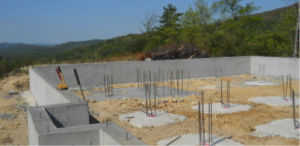This is a guest post by Rand Soellner; a founding member of ArCH (Architects Creating Homes, LLC).
 Win – Win – Win
Win – Win – Win
Recently the subject of specifications for residential architecture was discussed in detail on the EntreArchitect™ Podcast. This generated some interest in the subject nationwide, as it should.
Why?
If you are a licensed architect creating architectural documents for your projects, you might want to listen to that podcast and read this article. It just might save your projects, your firm and your livelihood. It may simultaneously help your client to obtain a better house and assist the contractor in doing a better job.
How?
Read on…
I know what you’re thinking;
“I’ve never done specs for my house projects and I get along just fine. I don’t intend to start now… after all, it’s just a house!”
Hmm. That’s an interesting point of view. Let’s examine some of those statements and the assumptions built into them.
So you’re PROUD of the fact that you don’t go to the trouble to carefully specify what products, materials and installation techniques should be on your projects? Really? Think about that.
You “get along just fine”? You do? Are you bulletproof? Are you aware of how litigious our society is these days? And you are omitting specifications of the dozens, possibly hundreds of items/conditions and other aspects in your CDs (Construction Documents)?
How many of your clients happen to be attorneys? Have you ever wondered what they could do to you in court, by pointing out to a judge and jury that you thought you “were just fine” and didn’t need to prepare any specifications for your project(s)? What could happen to your clients, in terms of their Health, Safety & Welfare (HS&W)? Ring a bell? Like the oath to which you swore on a stack of bibles when you became licensed?
We saved the best for last: “…after all, it’s just a house!” Wow. You must have guts, saying or even thinking something like that. ArCH, the AIA, the Federal Government of the USA and Canada and dozens of State purchasing offices recognize homes as one of the most detailed and complex types of projects an Architect can undertake.
Why?
Because there’s more going on per SF (Square Foot) in a house than in just about any other type of project.
I should know; I’ve been a licensed architect since 1982 and I’ve designed hospital projects (ICUs, triage areas, cardiology & pulmonary laboratories, ICUs (intensive care units), NICN (neonatal intensive care nurseries), NASA projects, military projects, the full range of educational facilities from grade schools through collegiate, experimental large research solar facilities, state laboratories, multi-story office buildings, restaurants, water plants and major theme parks (about half of Jurassic Park in Orlando), churches (working with a FLLW apprentice), airports (as in huge), Mid-Eastern large retail facilities, and quite a few other projects over the decades. So I do understand the full range of project types and complexities existing in the world today.
I’m here to tell you: designing, detailing and specifying a house is, in my opinion, is THE most complex type of project an architect can do. You should have seen the documents on the educational facilities, laboratories and theme park work! A house can be more complicated than those.
Sure, if you “dumb-down” your documents and make light of your responsibilities, you can make them “seem” to be simpler. If you’re doing a proper job, there’s quite a lot to describe, both graphically and in terms of specifications. Without which, contractors will be scratching their heads, or worse, “doing it the way we’ve always done it,” which likely won’t be in your client’s best interests or yours.
Think I’m making this up? Want some “for instances”?
Okay…
How about if you are on a borderline seismic zone and you haven’t specified the piers and foundation walls? The contractor will likely make them of either cast in place concrete or CMU (concrete masonry units (concrete block). Which will function better during an earthquake? Of course, the cast in place concrete. Which do you suppose the contractor will use, if you haven’t specified which to use? Of course, concrete block. When the earthquake comes, what do you suppose might happen? Nothing pleasant.
Here’s another one… You haven’t specified the siding or how it is to be installed. So, the contractor uses Hardie siding, (nothing wrong with that) but exposes the nail heads instead of blind nailing them (under the side or lapped boards from the side or above, as specifications would have described). Now you get thousands of exposed nail heads and instead of using galvanized or stainless steel nails, (because you didn’t specify them) the GC uses common (smooth) nails with no protective coating (rather than the ringshank nails you could have specified). So, within a couple of months, all of the nail heads are rusting, horrible streaks staining the siding below them, and because of the water intrusion through all those exposed punctures, the framing is absorbing water. It’s expanding and the common nails are starting to back out. Thousands of them. Care to hazard a guess what your client and their attorney might have to say about your practice of not specifying things, because to you: “It’s just a house”? I assure you, clients take their home VERY seriously.
You should, too.
After all, you’re the architect. Take pride in your work. Do a thorough job.
Want some more? In many states (I happen to be licensed in several), the State Board of Architecture publishes a “rogue’s gallery” of architects who have been disciplined or who are losing their licenses due to improper practices. I recall that one of these unhappy architects (who may no longer be an architect) didn’t detail or specify the flashing that is supposed to be on top of steel lintel angles that support masonry over an opening to a backup wall. Specification boilerplate could have handled this. But no! That architect was one of those who said “It’s just a house!” Well, the client didn’t think so and neither did their attorney, and neither did the Board of Architecture. Especially after water intrusion into the wall due to the lack of flashing (hey: simply noting: “comply with Code” doesn’t satisfy Boards of Architecture), and mold was growing in the walls, making their infant daughter sick with COPD and the framing was rotting, causing structural issues. Want to join that architect?
Now you’re going to say: “Well, I do provide some notes!”
Well, that’s nice. And is there any sort of organization to your notes, or are they simply what you, on this fine day, were able to think of about what a project should have described? “Flying by the seat of your pants” comes to mind. Or do you have an eidetic memory? You never overlook or forget anything? Really?
If you took your “notes” and put them into a systematic large list and then organized them by construction divisions over a series of decades…do you know what that’s called? SPECIFICATIONS.
Having your boilerplate specifications functions like a QC/QA (Quality Control/Quality Assurance) checklist. As you edit your specifications, you should also be fine-tuning your CDs (Construction Documents including your Working Drawings). Your specs can alert you to things you thought you handled but may not have. It can be downright comforting, knowing that your specs will remind you of all of the situations that should be in your documents.
I don’t know ANY architect anywhere who has ever said that using specs for any project was a waste of time. ALL of them say that it helps them to do a better job. Especially with houses.
Let’s not forget your client… Don’t they deserve your best efforts?
The GC? He/she may not be the bad person you thought they were. They may just need a helping hand so that they know how to do a better job for your shared client. They just might thank you, because specifications also helps their subcontractors and material suppliers do a better job.
The end result: Win-Win-Win.
 Rand Soellner, ArCH, NCARB, LHI is the Senior Staff Architect at HOME ARCHITECTS ®, an architectural company that designs custom homes for Clients nationwide. Rand is the recipient of design awards, energy awards and is one of the founders of ArCH. He is also a licensed home inspector.
Rand Soellner, ArCH, NCARB, LHI is the Senior Staff Architect at HOME ARCHITECTS ®, an architectural company that designs custom homes for Clients nationwide. Rand is the recipient of design awards, energy awards and is one of the founders of ArCH. He is also a licensed home inspector.
ArCHsuite™ is an integrated suite of forms, agreements, specifications and other products developed to assist the residential architect in the production of Construction Documents, Bidding, Construction Administration and management of the entire process. Learn about ArCHsuite™ here.

To even ponder a question to whether you should or should not write specs for house is a disaster. It will ultimately show in the work you do as an architect if you don’t. I agree with you, the client and most of all architecture deserves that specs be written. As an architect in our education we had a two year subject which was just on the writing of specifications. So from the word go it was instilled in us the importance of the specifications document.
Well worth the money and peace of mind to have a good set of specifications.
Well of course good specs are important, and including in the drawing set for residential projects definitely increases the chances of them being read…but not always followed. I caught this podcast and similar one on Business of Architecture. For my practice, I can’t imagine spending even $1500 for this product. There are plenty of sources for good specs out there: online and included with drawings I get from my consultants as well as manufacture specific specs. Being that they have to be edited and tailored to specific projects, specific climate, and user format anyway, I just can’t see the value. I am sure there is a customer out there for them though.
I try to avoid residential projects; however, I have occasionally been roped into doing one. I joke that I am not qualified because I do not have a degree in marriage counseling. But I digress.
When I have designed a residence, I have written concise specifications. Most of the time the owner has gotten involved (against my advice), contracted with a low bidder (estimate) with no reference to the specifications and then approved the contractor request to do things differently and disaster has followed.
I seldom have a problem with large commercial clients talking directly to a contractor, but residential clients do. How do the rest of you deal with this?
I’ve been wanting to learn more about this field and how it works. There are so many things that go into learning about this art, so its hard to learn more about it. This helped a ton and I can’t wait to learn more about it.